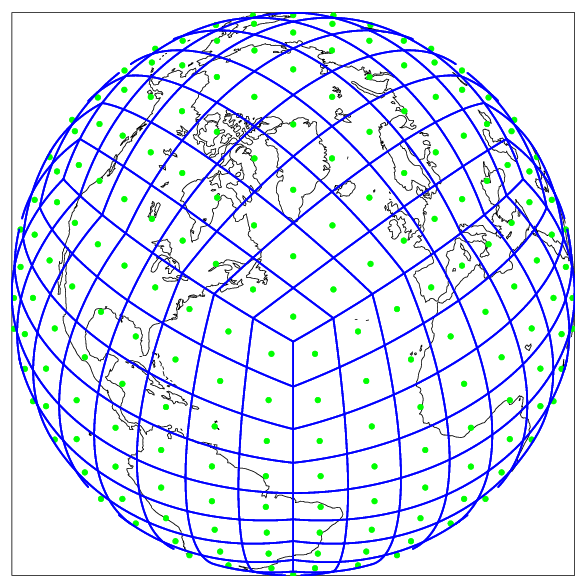CAM-SE works with data stored at Gauss-Lobatto-Legendre (GLL) nodes. These nodes can be interpreted in several ways shown in the three grids below. In all three grids, the GLL nodes are the same (the green dots in the figure). Internally, the dycore uses the CAM-SE native grid connectivity, but the rest of CAM and ACME has no knowledge of the grid connectivity and only sees data at GLL nodes and their associated area weight. The other other types of connectivity are not used within the model, but are sometimes used by pre- and post-processing tools.
...
In E3SM v2, we have the option to run the physics on a finite volume grid, where each spectral element cell is further divide into subcells. PG2 computes the physics on a 2x2 FV grid within each spectral element (shown below). On the physgrid, the physics columns are located at the cell center (green dots below), but should be considered cell average values over each FV cell, rather than nodal values at the green points.
For v2 simulations, most output will be on the PG2 physgrid.
SE "subcell" grid
Most analysis tools and other tools cannot handle higher order elements such as used in CAM-SE. For these codes, we produce metadata that divide each spectral element into subcells. This subcell grid is shown below. The GLL nodes are the vertices of the subcell grid. This meta data can be used by Paraview and Visit to plot native grid CAM-SE output. The metadata is stored in a grid template file that typically has a file name of the form "<gridname>_latlon_<date>.nc" in the grids directory of the ACME inputdata server. From Euler's polyhedron formula, we know if there are N physics columns (GLL nodes), there will be N-2 subcells (all quads) and N/2-1 subcell edges.
...
- For quasi-uniform cubed-sphere grids, ACME currently uses the "pentagons" option to construct the dual grid for making ESMF mapping files. To create these meta data grid files, we use a utility distributed with the ACME code - see acme/components/homme/test/templates.
- For RRM grids, ACME currently uses the "cheveron" option to construct the dual grid for making ESMF mapping files. To create these meta data grid files we use a Matlab program that performs a Newton interation. This matlab code is in the ACME PreAndPostProcessingScripts repo under regridding/spectral_elements_grid_utilities/
Future Plans
We note that the TempestRemap package uses an algorithm that understands both SE and FV grids (Ullrich & Taylor, MWR 2015) and can produce map files directly from the CAM-SE Native grid. It only needs the SE Native grid (the first grid shown on this page) and does not need any type of dual grid. These mapping files are more accurate since they take advantage of the SE discretization. If ACME atmosphere adopted TempestRemap mapping files, we will not need to use the SE dual grid.
...
